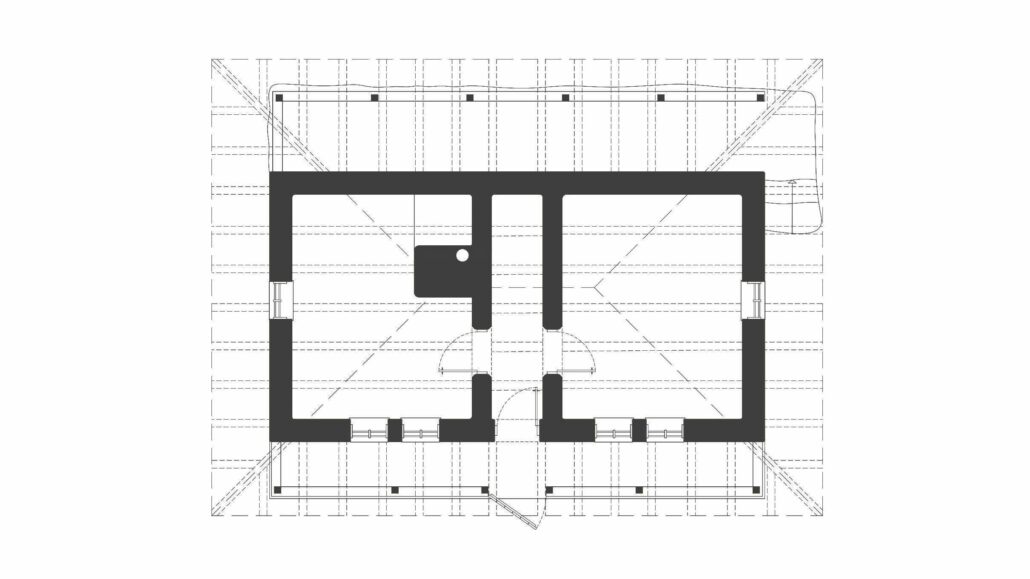This plan really moved us. Not only because it is novel (at least, we could not find it elsewhere), but also because the drawing does not belong to Horia Creangă[1], the Modernist hero of romanian architecture, but it traces the house of his grandfather, Ion Creangă – the hero of romanian literature. Belongs is a way of putting it, as Ion Creangă, a peasant’s son-turned-priest most certainly did not draw a single line on any paper. He actually didn’t build thedwelling, he bought it. It is a minimal house, in a poor district of the Moldavian city of Iaşi, and which had its share of issues since the very first years.
Text: Ștefan Ghenciulescu
Reconstruction of the plan: Andrei Culinescu, Rora paliga, Matei Barbu, Tudor Stănilă
Cătălina Frâncu, who has written about this ‘bojdeuca’ (hovel) in a book we are intensely working on, found the following lines in a letter Creangă seent to Titu Maiorescu, in 1887:
“In the hovel I live in, I’m still sleeping outside in this weather, on 18/19 September. Were you to be patient, as you have always been kind, you might probably ask: where is this hovel of mine? I will respectfully answer this: in the Ţicău borough, which some call the Valley of Tears, 4, Ţicăul de Sus St. (if one could apply the name of street to a postern alley, with knee-deep mud when long heavy rains are falling, the kind people also call rotten, and with mounds of dust in droughty weather). And this hovel of a house that I’ve been living in for some 18 years is made of wattle and daub and leaning to fall down each day that goes by, were it not supported by some 24 oak poles, themselves rotten as well. During winter, I sleep in a beat-up small room, and during summer on a porch at the back, from May up to October, when the weather holds, as it does now. This is what I’ve grown accustomed to.”[2]
The plan, together with the above quote and with what else we know about Creangă, also teach us, I believe, or rather highlight, a few things:
Although the house is so small, over a third of it are open and covered spaces; the strictest economy could not make do without essential spaces—even two here: the front porch and the porch at the back. In the 19th century, sheltered exterior spaces were not a luxury, but were rooms in the open air, as important as the ones inside. Nowadays, irrespective of how much money or space we had, in the city or in the countryside, we cannot bear not enclose everything, glazing as mad existing balconies, terraces, loggias, in truth recovering a loss.
Besides, work, including intellectual work, requires a good and pleasant place, not necessarily a dedicated place. As Cătălina has learned, Creangă would work everywhere: first, on his porch, in summertime, and, during winter, in the huge bed he shared with Tinca, his life companion, a bed which took up almost all the space in the good, stove-heated, room.
Finally, a word on drawing and idealizing. This drawing is not a house plan drawn after measurements, but a restoration based on old and new images. The actual building may have been more crooked, even softer. Nevertheless, it has kept changing since it became Romania’s first memorial house, from a concrete support construction, to the back veranda being enclosed by glass (yes, also here). This reconstruction, as rigorous as possible, continues to have the quality of speaking of some essential values of the tiny house: it is almost rationalist in its simplicity and speaks of spatial and building archetypes, of the logic of division and structure, of general symmetry and detail asymmetry… It expresses a model. And it makes us dream that Horia Creangă may not have been completely ashamed with it.
Notes
[1] Interwar architect, author of iconic Modernist buildings, mainly in Bucharest. He was the grandson of Ion Creangă, a classic Romanian writer. Born into a peasant family, he was a (later defrocked) priest and schoolteacher, a writer of tales, short stories and a memoir.
[2] Iulian Pruteanu‑Isăcescu, Bojdeuca „Ion Creangă”. Din istoria primului muzeu literar din România [Ion Creangă’s Hovel. From the History of Romania’s First Literary Museum], Muzeul Naţional al Literaturii Române Iaşi/National Museum of Romanian Literature, Iași


